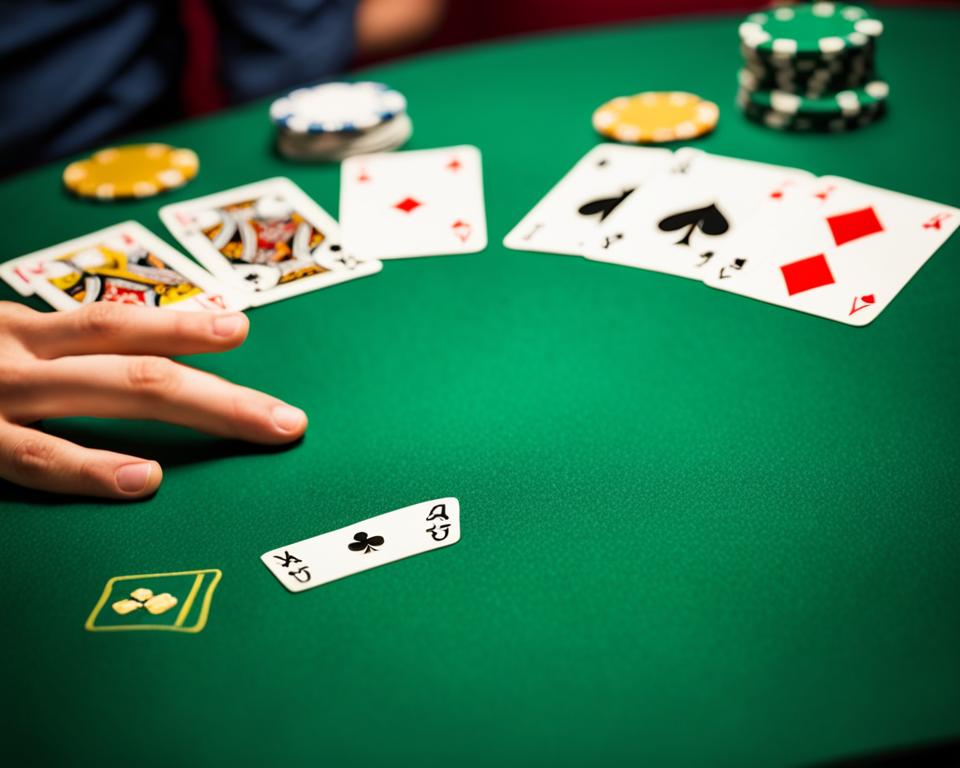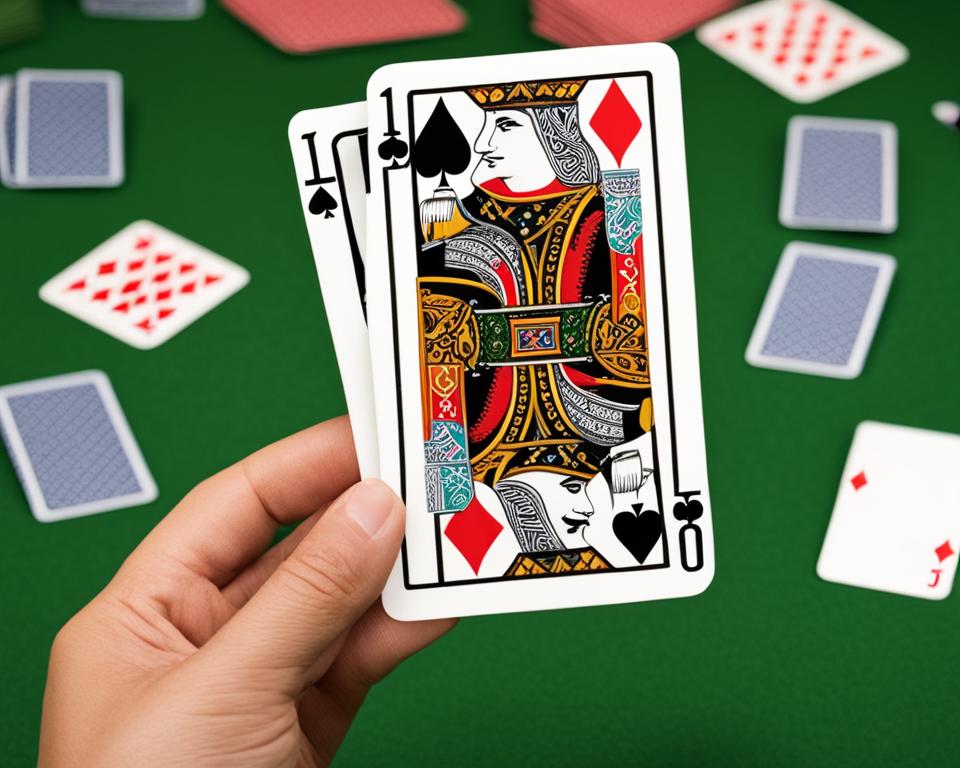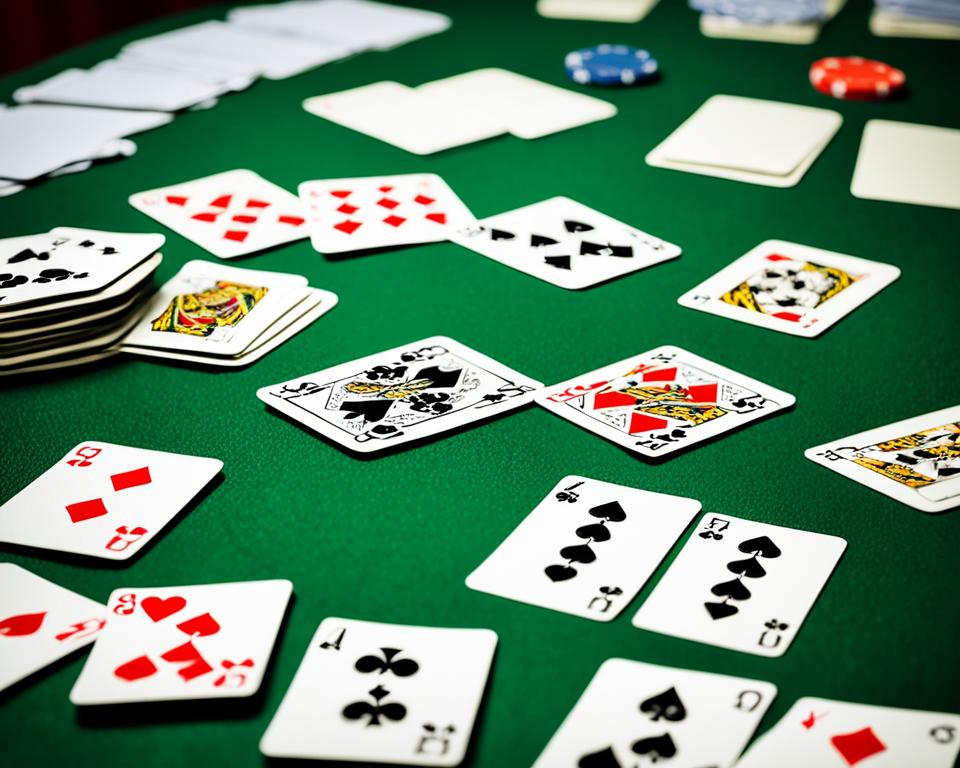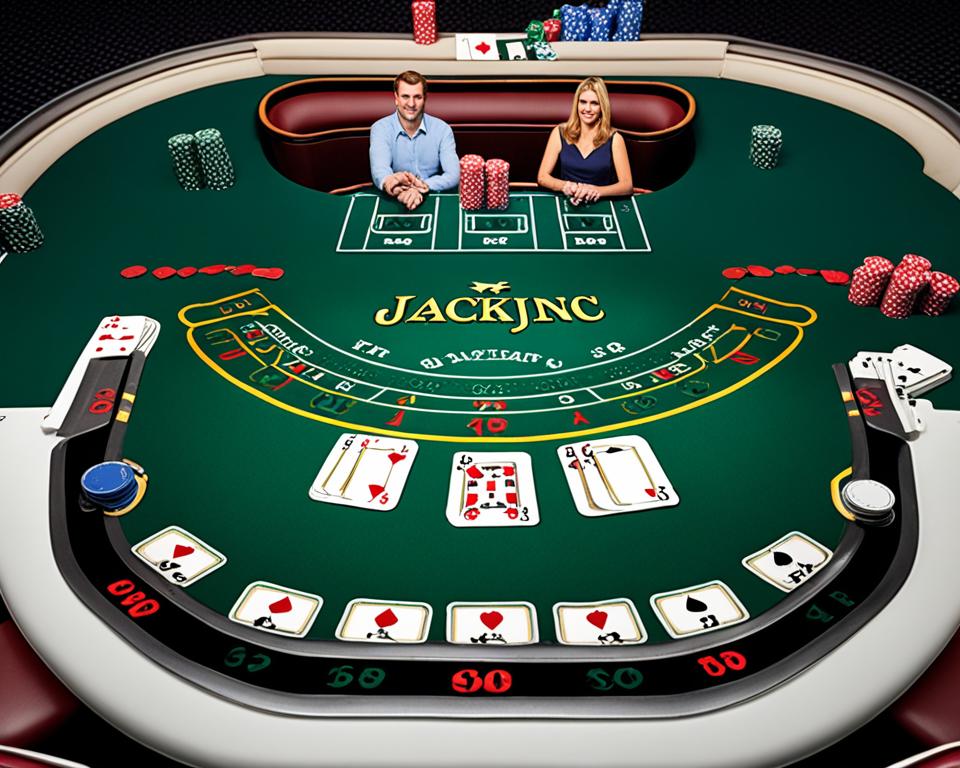If you’re new to blackjack and looking for strategies that can help you get started on the right foot, you’ve come to the right place. This article will provide you with easy blackjack strategies tailored specifically for beginners. By mastering these tips and techniques, you’ll increase your chances of winning and have more fun at the tables.
Before we dive into the strategies, it’s important to understand the basic terms of the game and the house advantage. By familiarizing yourself with these concepts, you’ll be better equipped to make informed decisions during gameplay.
Key Takeaways:
- Memorize the basic terms of blackjack to incorporate them into your betting strategies.
- Understand the house advantage and how it affects your chances of winning.
- Study basic blackjack strategy to make more informed decisions on when to hit, stand, double down, or split.
- Know the table’s game rules, including the number of decks used and the dealer’s action on a soft 17.
- Check the table’s blackjack rules, especially the payout for a blackjack, as it affects your odds of winning.
Understanding the Basic Terms of Blackjack
To become a skilled blackjack player, it’s important to familiarize yourself with the basic terms of the game. Not only will this help you navigate through the gameplay, but it will also enable you to incorporate these concepts into your betting strategies. By understanding terms like “double down,” “split,” and “surrender,” you’ll enhance your chances of winning.
Let’s take a closer look at these essential blackjack terms:
1. Double Down
When you have a strong hand, you can choose to double down. This means you can double your original bet and receive only one additional card. It’s a strategic move to maximize your winnings when you believe you have a strong chance of beating the dealer.
2. Split
If the first two cards dealt to you are of the same rank (value or face), you have the option to split your hand. By doing so, you create two separate hands and place an additional bet equivalent to your original wager. Each hand is then played independently, giving you an opportunity to win with both.
3. Surrender
At times, you may find yourself in a situation where your initial hand seems unfavorable compared to the dealer’s up card. In such cases, you can surrender your hand and save half of your original bet. It’s a strategic move to minimize your losses when you feel your chances of winning are slim.
Now that you have a clear understanding of these basic blackjack terms, you’ll be better equipped to make informed decisions while playing. Incorporate these concepts into your overall strategy and watch your success at the blackjack table soar!
| Term | Definition |
|---|---|
| Double Down | Doubling the original bet and receiving one additional card to potentially increase winnings |
| Split | Dividing initial hand into two separate hands with an additional bet when dealt two cards of the same rank |
| Surrender | Forfeiting half of the original bet to minimize losses in unfavorable situations |
Remember, mastering the basic terms of blackjack is just the start of your journey to becoming a skilled player. In the next section, we’ll explore how to mitigate the house advantage and react to the cards you’re dealt. Stay tuned!
Mitigating the House Advantage
In blackjack, the dealer holds a slight advantage over players because they must act first. Understanding and mitigating this house advantage is crucial if you want to improve your chances of winning. As a player, you need to react strategically to the cards you have and predict the dealer’s face-down card.
Reacting to the cards you have involves making informed decisions based on the value of your hand and the dealer’s up card. For example, if you have a low hand value, it may be wise to hit (request another card) to improve your hand. Conversely, if you have a strong hand, standing (staying with your current hand) may be the better choice.
Predicting the dealer’s face-down card requires observation and deduction. While you can’t know the exact card, you can make educated guesses based on the dealer’s up card and the known composition of the deck. Paying attention to the cards already played and applying basic probability principles can help you make more accurate predictions.
Remember, predicting the dealer’s face-down card is not about clairvoyance or cheating; it’s about playing smart and increasing your chances of success.
By reacting strategically to your cards and predicting the dealer’s face-down card, you can level the playing field and reduce the house advantage in blackjack. Developing these skills takes practice and experience, but with time, you can become a more skilled player and enhance your overall gameplay.
Understanding Card Combinations
Knowing the different combinations of cards in a deck can also aid in predicting the dealer’s face-down card. Familiarize yourself with the probabilities and frequencies of different card values to improve your decision-making.
| Card Value | Number of Cards |
|---|---|
| Ace | 4 |
| 2-9 | 24 |
| 10, Jack, Queen, King | 16 |
As you can see from the table above, there are four aces in a deck, which increases the chances of the dealer having an ace. Similarly, there are more 10s, face cards, and small cards (2-9) in a deck, so considering these probabilities can help you make more informed predictions.
Remember, mitigating the house advantage is not about guaranteeing victory with every hand, but rather improving your overall odds of winning. By honing your skills in reacting to cards and predicting the dealer’s face-down card, you’ll be taking important steps towards becoming a more successful blackjack player.
Studying Basic Blackjack Strategy
Blackjack is a game of probabilities, and one way to improve your chances of winning is by studying the basic blackjack strategy. By understanding the optimal moves for each hand, you can make more informed decisions and maximize your potential outcomes.
Playing Certain Hands
Knowing how to play certain hands can significantly impact the outcome of your blackjack game. The basic blackjack strategy provides guidelines for when to hit, stand, double down, or split depending on the cards in your hand and the dealer’s upcard.
“A basic strategy player should choose to hit a hard 12 against a dealer’s 2 or 3 and stand against a 4 through 6. These decisions are based on the probabilities of busting and winning at various points.”
By following the basic blackjack strategy, you can minimize the house edge and increase your overall odds of winning. It is essential to familiarize yourself with these recommendations and practice implementing them during your gameplay.
Using a Strategy Chart
A strategy chart is a valuable tool that can assist you in memorizing and applying the basic blackjack strategy. The chart presents a simplified version of the strategy, listing the optimal moves for each possible combination of player hand and dealer upcard.
| Player’s Hand | Dealer’s Upcard | Optimal Move |
|---|---|---|
| Hard 9 or less | Any | Hit |
| Hard 10 or 11 | Any | Double Down |
| Hard 12 to 16 | 2 to 6 | Stand |
| Hard 12 to 16 | 7 to Ace | Hit |
| Soft 13 to 18 | Any | Hit |
| Pair of 2s, 3s, 6s, 7s, or 8s | Any | Split |
| Pair of 4s | 5 or 6 | Split |
| Pair of 4s | Any other | Hit |
| Pair of 5s | 2 to 9 | Double Down |
| Pair of 9s | 2 to 6, 8 or 9 | Split |
| Pair of 9s | 7 | Stand |
| Pair of 9s | 10 or Ace | Hit |
Referencing a strategy chart during your blackjack sessions can help you make quick and accurate decisions, especially when faced with complex hand combinations. It is advisable to familiarize yourself with the chart and practice using it so that the optimal moves become second nature.
By studying the basic blackjack strategy and utilizing a strategy chart, you can enhance your gameplay and potentially improve your results. Remember to apply these strategies responsibly and adapt to different game variations and rule sets to optimize your playing experience.
Knowing the Table’s Game Rules
When playing blackjack, it’s essential to understand that different casinos or blackjack games have their own set of rules. Being familiar with the table’s game rules can greatly influence your decision-making and overall strategy.
One of the variations you may encounter is the use of multiple decks of cards. This practice is often employed to discourage card counting, a technique some players use to gain an advantage over the casino. By incorporating multiple decks, the likelihood of accurately tracking cards decreases, leveling the playing field.
Another important rule to be aware of is the dealer’s soft 17. In some games, the dealer is allowed to hit on a soft 17, which is a hand that includes an Ace. This rule impacts the dealer’s decision-making process, potentially affecting the outcome of the game. Understanding whether the dealer hits or stands on a soft 17 can help shape your own strategy.
By familiarizing yourself with the table’s game rules, including the use of multiple decks of cards and the dealer’s actions on a soft 17, you can adapt your gameplay accordingly. Now let’s take a look at an example table that showcases some of the varying rules you may come across.
| Table Rules | Multiple Decks | Dealer’s Soft 17 | Blackjack Payout |
|---|---|---|---|
| Table 1 | 6 decks | Dealer hits | 3:2 |
| Table 2 | 8 decks | Dealer stands | 3:2 |
| Table 3 | 2 decks | Dealer hits | 6:5 |
As illustrated in the table above, different tables can have varying combinations of multiple decks, the dealer’s actions on a soft 17, and blackjack payout ratios. It is crucial to select a table that aligns with your preferred gameplay and strategy to optimize your chances of success.
Now that you have a better understanding of the table’s game rules, let’s move on to the next section to explore the specific rules relating to blackjack payouts and odds.
Checking the Table’s Blackjack Rules
Before you start playing blackjack, it’s important to understand the specific rules of the table you’re playing at. The table’s blackjack rules can significantly impact your gameplay and potential winnings. One crucial aspect to consider is the blackjack payout.
Table payouts for a blackjack can vary from one casino to another. Some tables offer a 3:2 payout, which means that if you win with a blackjack, you’ll receive three dollars for every two dollars you wagered. However, there are tables that only pay out at a rate of 6:5, giving you a lower return. It’s advisable to avoid tables with lower payouts as they provide worse odds and diminish your potential winnings.
When choosing a table, make sure to inquire about the blackjack payout rate before placing your bets. This information will help you make an informed decision and select a table that offers better odds and a more favorable payout for your blackjack hand.
By understanding and considering the table’s blackjack rules, particularly the payout, you can enhance your chances of a successful and rewarding experience at the blackjack table. So, before you pull up a seat, take a moment to check the table’s specific blackjack rules to ensure you’re playing under favorable conditions. Your bankroll will thank you!
Formulating Your Betting Strategy
When playing blackjack, it’s crucial to have a well-defined betting strategy. By establishing a solid plan, you can increase your chances of winning and maintain consistency throughout your gameplay.
First and foremost, it’s important to remember that there are no foolproof strategies that guarantee a win every time. Nevertheless, certain approaches can help you make more informed decisions and optimize your overall betting experience.
One popular strategy is to remain consistent with your bets or gradually increase them by small increments. Consistency allows you to minimize losses during unfavorable periods and capitalize on winning streaks. By sticking to a predetermined pattern, you can better manage your bankroll and avoid impulsive decisions that may lead to unnecessary risks.
It’s essential to ignore superstitions or misconceptions about being due for a win or the idea of hot and cold decks. These concepts have no scientific basis and can potentially distract you from implementing a rational and effective betting strategy.
“Consistency is key when it comes to betting in blackjack. By staying focused and following your predetermined strategy, you can maintain control and increase your chances of success.”
Remember that developing your betting strategy takes time and practice. Experiment with different approaches to find what works best for you. Whether you choose to remain consistent or gradually increase your bets, the key is to remain disciplined and avoid impulsive decisions that could jeopardize your bankroll.
Next, let’s explore how to assess the odds and adjust your bets accordingly when you have an advantage over the house.
Increasing Bets When the Odds are in Your Favor
In blackjack, understanding the odds and adapting your betting strategy accordingly can significantly enhance your chances of winning. When the deck contains a high proportion of high cards, the odds are in your favor. High cards, such as tens and face cards, are advantageous because they increase the possibility of getting a blackjack (an Ace and a face card) or a strong hand.
To capitalize on the favorable odds, it is recommended to increase your bets when high cards are likely to appear. This strategy, known as aggressive betting, involves adjusting your wager size based on the perceived advantage.
One effective way to determine the likelihood of high cards is by maintaining a running count. The Hi-Lo method is a popular card counting system that assigns values to cards. As you observe the cards being dealt, you keep a running count by subtracting the low-value cards (2 to 6) and adding the high-value cards (10 to Ace). The resulting count indicates the proportion of high cards remaining in the deck.
“Increasing your bets when the odds are in your favor allows you to maximize your potential winnings and take advantage of favorable circumstances.” – Blackjack Pro
Gauging the Remaining Helpful Cards
To gauge the remaining helpful cards in the deck accurately, you must calculate the true count. The true count is determined by dividing the running count by the estimated number of decks still in play. This adjustment accounts for the varying number of decks used in different casinos or games.
Once you have determined the true count, you can confidently increase your bets when the count is high. A high count indicates an abundance of high cards, which significantly improves the chances of obtaining strong hands or blackjack.
Avoiding Detection
While increasing your bets during favorable conditions is a strategic approach, it is crucial to remain inconspicuous to avoid detection by casino staff. Maintaining an air of nonchalance and imitating natural betting patterns can help prolong your gameplay.
It is also advisable to leave the table once your consistent winning attracts suspicion. Remember, the goal is to optimize your advantage, mitigate risk, and enjoy a profitable blackjack session.

| Card Count | Betting Strategy |
|---|---|
| Positive Count (High) | Increase bets by a predetermined factor (e.g., 2x or 3x) |
| Neutral Count | Maintain current bet size |
| Negative Count (Low) | Reduce or minimize bets |
By increasing your bets when the odds are in your favor, you can take advantage of the inherent favorable conditions and optimize your profits in blackjack. However, it is important to remember that gambling involves risks, and responsible gaming should always be prioritized.
Avoiding the Insurance Bet
When playing blackjack, you may come across the option of making an insurance bet. This side bet is offered when the dealer’s face-up card is an ace. The insurance bet is essentially a wager on whether the dealer will have a blackjack (a two-card hand totaling 21). While it may seem tempting to protect your original bet, the reality is that the insurance bet is not a profitable choice in the long run.
It’s important to understand that the insurance bet has a significantly higher house edge compared to the main blackjack game. The house edge on the insurance bet can range from around 5% to over 7%, depending on the specific casino rules and the number of decks used. This means that, on average, you will lose more money by making the insurance bet than if you simply forfeited it.
Beginners are often drawn to the insurance bet because they fear the possibility of the dealer having a blackjack. However, it’s crucial to remember that the insurance bet is not an effective strategy to counter the dealer’s potential blackjack. It’s a separate bet with its own odds and outcomes that ultimately work against the player’s long-term profitability.
Card counting is a more advanced technique that some players use to gain an edge in blackjack. By keeping track of the cards that have been dealt, a skilled card counter can make more accurate predictions about the likelihood of the dealer having a blackjack. In specific card counting scenarios, the insurance bet can have a positive expected value, making it a worthwhile option. However, card counting requires a high level of skill and practice, and beginners should not rely on it.
For novice players, it is generally recommended to avoid making the insurance bet and focus on understanding and utilizing basic blackjack strategy instead. By learning when to hit, stand, double down, or split based on the value of your hand and the dealer’s upcard, you can make more informed decisions that improve your chances of winning in the long run.
| Insurance Bet | Basic Blackjack Strategy |
|---|---|
| High house edge | Lower house edge |
| Separate bet with unfavorable odds | Strategic decisions based on hand value and dealer’s upcard |
| Not recommended for beginners | Recommended for all players |
Understanding Card Counting
Card counting is a strategy used by advanced players to gain an edge in blackjack. By keeping track of the cards that have been played, players can make more informed decisions on their bets and playing strategies. One common method of card counting is the Hi-Lo system, which assigns specific values to each card.
The Hi-Lo method works by assigning a value of +1 to cards from 2 to 6, a value of 0 to cards from 7 to 9, and a value of -1 to cards from 10 to Ace. By keeping a running count of these values as the cards are dealt, players can estimate the proportion of high cards (which are favorable to the player) to low cards (which are favorable to the dealer) remaining in the deck.
However, it’s important to note that card counting is not an exact science, and it requires practice and concentration. Players must keep track of the running count while making decisions and bets, which can be challenging in a live casino environment.
To refine their card counting strategy, players can also calculate the true count. The true count takes into account the number of decks remaining in the shoe. By dividing the running count by the number of decks left to be played, players can determine the true count. This helps adjust the betting strategy based on the remaining favorable cards.

With an accurate understanding of the running count and true count, players can make more strategic decisions on when to increase their bets. A higher true count indicates a greater advantage for the player, as there are more favorable cards left in the deck. On the other hand, a lower true count suggests the opposite and may warrant smaller bets or even sitting out hands.
It’s important to note that while card counting is not illegal, it is frowned upon by casinos. Therefore, it’s crucial to employ inconspicuous play and avoid drawing attention to oneself. Players should also be aware that card counting is most effective in games with a high deck penetration, meaning that a larger portion of the shoe is dealt before reshuffling.
By mastering the art of card counting and effectively adjusting their betting strategy, players can significantly improve their chances of winning in blackjack. However, it’s crucial to remember that luck and variance still play a role in the outcome of each hand. Always play responsibly and within your means.
Adjusting Your Betting Based on Card Counting
Once you have mastered the art of card counting, it’s time to put your newfound skill to use and adjust your betting accordingly. When you have a high count, indicating that there are more favorable cards left in the shoe, it’s a sign that it’s time to raise your bets. This way, you maximize your potential winnings when the odds are in your favor.
However, it’s important to remain inconspicuous and natural in your play. You don’t want to draw unnecessary attention to your card counting abilities, as casinos frown upon this practice. Keep a low profile, blend in with other players, and avoid any behavior that could arouse suspicion.
“The key to successful card counting is subtlety. Inconspicuous play is crucial to fly under the radar and avoid being detected by casino staff.”
Additionally, it’s advisable to leave the table when your winning streak attracts suspicion. Casinos closely monitor players who consistently win large amounts, and you don’t want to risk being barred from playing. Playing inconspicuously and leaving at the right time is essential to protect your profits and maintain a positive relationship with the casino.
Remember, card counting is an advanced technique that requires practice and skill. It should be approached with caution and used responsibly. By adjusting your bets based on card counting, you can significantly increase your chances of winning in blackjack. Just be sure to do so in a discreet and respectful manner.
Recommended Reading:
- The Theory of Blackjack by Peter Griffin
- Blackjack Bluebook II: The Simplest Winning Strategies Ever Published by Fred Renzey
| Card Count | Recommended Bet Adjustment |
|---|---|
| High Count | Increase your bets by a predetermined factor (e.g., 2x or 3x) |
| Moderate Count | Maintain your current bet or slightly increase it |
| Low Count | Minimize your bets or bet the table minimum |
Conclusion
Conclusion
By implementing these easy blackjack strategies, beginners can significantly improve their chances of winning at the tables. Memorizing the basic terms of the game, such as double down, split, and surrender, allows players to incorporate them into their betting tactics. Understanding the house advantage in blackjack and reacting to the cards in hand enables players to make informed decisions that maximize their winning potential.
Studying basic blackjack strategy is fundamental for any player starting out in the game. By referring to a strategy chart and understanding when to hit, stand, double down, or split, beginners can make strategic moves that increase their odds of beating the dealer. It’s crucial to familiarize oneself with the specific game rules of the table being played at, as different casinos or games may have variations that can impact decision making.
While card counting is an advanced technique, it is worth considering as players progress in their skills. Through methods like the Hi-Lo system and keeping track of the running count and true count, experienced players can adjust their betting strategy based on the advantageous or disadvantageous composition of the remaining cards in the deck. However, it is important to note that card counting is not suitable or legal in all gambling establishments.
Remember, while employing these strategies, always play responsibly and within your means. Blackjack is an exciting game that requires skill, strategy, and a bit of luck. By starting out with these beginner-friendly tactics, players can enjoy the game while increasing their chances of success.
FAQ
What are some easy blackjack strategies for beginners?
Some easy blackjack strategies for beginners include memorizing basic terms, understanding the house advantage, studying basic blackjack strategy, knowing the table’s game rules, and checking the table’s blackjack rules.
What are the basic terms of blackjack that beginners should know?
Beginners should familiarize themselves with terms such as “double down” (doubling your bet), “split” (playing two hands with two separate bets), and “surrender” (saving half your bet).
How can beginners mitigate the house advantage in blackjack?
Understanding that the dealer has an advantage in blackjack because players must act first will help beginners react to their own cards and predict the dealer’s face-down card, ultimately increasing their chances of winning.
Should beginners study basic blackjack strategy?
Yes, studying basic blackjack strategy is important for beginners. By learning when to hit, stand, double down, or split according to a strategy chart, players can make better decisions and improve their gameplay.
What should beginners know about the game rules at the blackjack table?
Beginners should be aware that different casinos or blackjack games may have different rules. This can include the use of multiple decks of cards to discourage card counting or allowing the dealer to hit on a soft 17 (a 17 made with an ace).
How should beginners check the blackjack rules for a specific table?
Before playing, beginners should find out how the table pays for a blackjack. Some tables pay 3:2 (three dollars for every two dollars wagered), while others pay 6:5. It is advisable to avoid tables with lower payouts as they offer worse odds.
What is important when formulating a betting strategy in blackjack?
When formulating a betting strategy, it is important to be consistent or increase bets by small amounts until a win is achieved. It is also crucial to avoid superstitions like being due for a win or relying on hot and cold decks.
How can beginners increase bets when the odds are in their favor?
Beginners can increase their bets when the odds are in their favor by learning to gauge the remaining helpful cards in the deck. When there are more high cards in the deck, it is advantageous to bet more aggressively on good hands.
Should beginners make the insurance bet?
Unless they are card counting, beginners should avoid making the insurance bet. While it may seem like a side bet that protects against the dealer having a blackjack, it is not profitable in the long run.
What is card counting and should beginners try it?
Card counting is a strategy used by advanced players to gain an edge in blackjack. Beginners can learn about card counting, such as the Hi-Lo method which assigns values to cards, but it is not necessary for beginners to try it until they advance their skills.
How should players adjust their betting based on card counting?
When the card count is high based on card counting, players can raise their bets to take advantage of the favorable odds. It is important to remain inconspicuous and natural in play to avoid drawing suspicion from the casino. Additionally, players should know when to leave the table if their winning streak attracts unnecessary attention.
Do these easy blackjack strategies increase the chances of winning?
Yes, using these easy blackjack strategies for starters will increase the chances of winning. By memorizing basic terms, understanding the house advantage, studying basic blackjack strategy, knowing the table and blackjack rules, and considering card counting as skills improve, players can enhance their gameplay and increase their chances of winning. However, it’s important to always play responsibly and remember to have fun.





